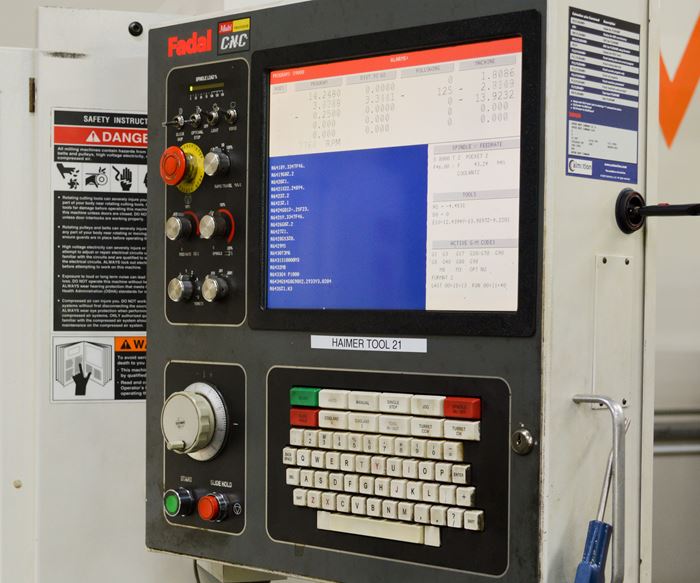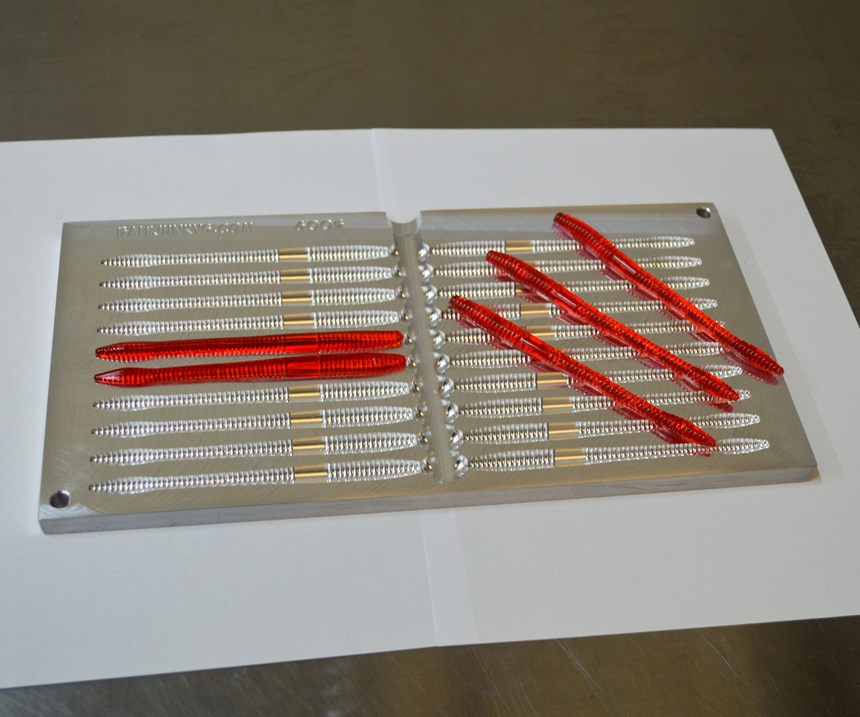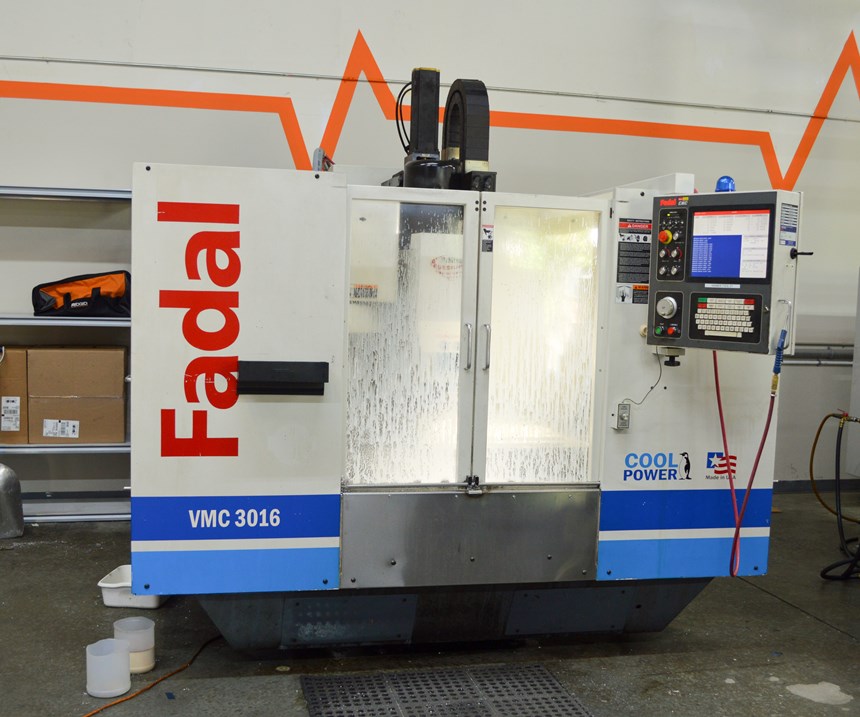New Control Improves Feed Rates on Remanufactured Legacy Machine
Replacing the original 25-year-old control on an otherwise sound remanufactured VMC enabled a moldmaker to increase feed rates, cut cycle times and increase profitability.
Share



When Baitjunkys purchased a remanufactured machine to produce molds for fishing lures, it needed the old machine to run like new. Mechanically, it did just fine, but its 25-year-old control could not handle higher feed rates without compromising accuracy. A new control from Calmotion (Chatsworth, California) has enabled the machine to reach its full potential, helping the company fill its backlog and increase its profitability.
Limited by Feed Rates
Leonard Smith founded Baitjunkys in 2013. He had grown dissatisfied with the service he was receiving from his mold supplier, so he decided to go into business for himself. He bought a Mach III CNC knee mill, put it in his garage and taught himself how to use it. The company has since moved out of the garage into a commercial space in Lawrenceville, Georgia, near the Lake Lanier reservoir, where the hobbyist- and professional-grade fishing lures produced with Baitjunkys’ molds can be used. In addition to adding more space, Baitjunkys has also added more machines. In addition to the original knee mill, the shop now has a Mazak VTC-20C vertical turning center as well as the remanufactured Fadal 3016 HT vertical machining center (VMC).
“The [Fadal] machine was in good shape mechanically, but it still had the original CNC, which was probably 25 years old at that point,” Mr. Smith says. The fastest he could feed the 0.1875-inch diameter, two-flute end mills used to cut aluminum mold cavities was 50 ipm. At faster feed rates, accuracy suffered. The reduced feed rates were causing him to miss production quotas. Delivery dates slipped, and the company’s backlog grew.
Fishing for Solutions, Catching a New Control
A friend of Mr. Smith’s who had experienced the same issues with his Fadal suggested a solution: a new control from Calmotion. Mr. Smith was already familiar with the company. Shortly after buying the Fadal, he began experiencing slowdowns while drip-feeding large programs through its RS-232 port. By installing one of Calmotion’s USB-to-CNC adapters, he was able to reduce the program load time from roughly 18 minutes to 15 seconds.
Calmotion specializes in providing a range of replacement parts such as amplifiers, motors, cables and other accessories for machine tools, including Fadal machines. One of its products is the 527F CNC, a full-featured digital control replacement. Although Mr. Smith was cash-strapped from buying the machine, he decided to make the investment. “It was the best thing I could have done,” he says.
“There are a large number of Fadal owners whose machines are still functioning well but who need higher processing speeds,” says Calmotion software engineer Glenn de Caussin. The replacement control, which he helped to develop, is a relatively small investment when compared to the cost of purchasing a new machine, and only requires an hour or two of downtime to install. “What’s more, you don’t have to pay us to come install it, or waste time on training or reprogramming,” he adds.
According Mr. de Caussin, the 527F’s processor is 20 to 30 times faster than the ones found on older Fadal machines like the one Baitjunkys owns, thereby enabling increased interpolation rates. The new control also includes several new features not found on the old one, including advanced ramp control, improved block-processing speeds, a flexible memory system for simplified program management and networking capabilities.
The 527F has a multi-processor architecture similar to the legacy Fadal control, but uses newer, faster electronics. Mr. de Caussin says this enables the digital signal processors to execute complex mathematical calculations in a single clock cycle (a single electronic pulse of a CPU). The control also has integral hardware peripherals such as analog-to-digital converters, improved encoder feedback and high-speed communications that were not possible on older units. “These capabilities, not found in the original Fadal control, allow the machine operator to push the iron to its maximum potential,” he says.
Despite Mr. de Caussin’s caution of a couple hours’ downtime, Mr. Smith says he was able to install the new control on his own in about an hour. “If you’re smart enough to program a CNC machine, you’ll have no problem putting in one of these controls,” he says.
Making Adjustments for Faster Cycle Times
With the new control installed, the next step for Mr. Smith was to adjust the feeds and speeds accordingly. “Realistically, I could have just hit cycle start and it would have worked right out of the box,” he says, “but the previous feeds and speeds were so conservative that I had to go through and bump things up.”
With the new control, he was able to increase feed rates to 180 ipm, which has led to a significant improvement in cycle time. “As it stands, my cycle time went from 4.5 hours to just over 2 hours without having to change anything but the feed rate,” he says. He adds that he believes that feed rates of 250 ipm would be possible if he were to switch to a larger cutting tool.
The new control provides some additional benefits beyond the ability to increase feed rates. It accepts his legacy machine programs without reposting or code modifications. Mr. Smith was also able to maintain the postprocessor on his BobCAD-CAM programming system. Also, because the control’s user interface is virtually identical to the old one, he was able to run the machine without additional training. It also increased program storage from 2 megabytes to 16 gigabytes and provides native USB and Ethernet capabilities.
Although the new control was an investment for Mr. Smith, it paid off in the end. “The cost of replacing the control with the Calmotion is the equivalent of two payments on a new machine,” he says. “I recouped my costs within the first few months just on the cycle time reduction. For someone doing production work, it would be an even faster payback.”
Related Content
Easy-To-Install Data Acquisition System for Real-Time Monitoring Across Brands
cnSEE from All World Machinery Supply combines easy installation and monitoring across multiple machines.
Read MoreRoyal Products Introduces Versatile Three-Jaw Chuck
IMTS 2024: Royal Products features a Three-Jaw Chuck for CNC workholding, designed to reduce setup time between jobs and for the utilization of a range of top tooling.
Read MoreGoing Hands-On with Heidenhain and Acu-Rite Solutions
Heidenhain and Acu-Rite Solutions are offering several hands-on experiences at their booth this year, as well as internal components that reduce energy use.
Read MoreFANUC Details Robotic Vision, ROBODRILLS and More at IMTS 2024
FANUC’s IMTS 2024 booth includes real-time demonstrations that show the abilities of its equipment, including robots, controllers and machine tools.
Read More





























